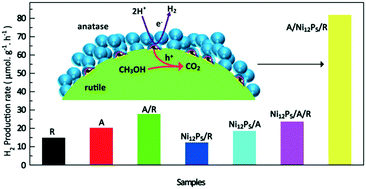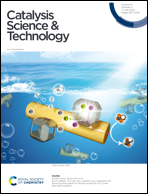Regulation of the rutile/anatase TiO2 heterophase interface by Ni12P5 to improve photocatalytic hydrogen evolution†
Abstract
Anatase/rutile TiO2 heterophase junction composites have been documented to have much higher photocatalytic activity than single phase TiO2 (nude anatase or nude rutile) for various chemical reactions, including hydrogen production from methanol–water solution and pollution degradation. Further improving the photocatalytic performance of heterophase junction photocatalysts is a subject worth studying in both theory and practice. Based on the concept of junction interface regulation and our previous findings, we embedded Ni12P5 nanoparticles at the interface between anatase (A) and rutile (R) TiO2 by a multi-step preparation method to obtain an A/Ni12P5/R composite with a sandwich-like structure. It was found that loading Ni12P5 on the outside surface of anatase TiO2 (Ni12P5/A), rutile TiO2 (Ni12P5/R), P25 TiO2 (Ni12P5/P25), and A/R composite (Ni12P5/A/R) leads to a decrease in the photocatalytic activity; however, interestingly, the A/Ni12P5/R sample showed higher photocatalytic activity than the other samples of loaded or unloaded Ni12P5, although the loaded Ni12P5 in the latter case is inaccessible to the reactant molecules. This abnormal phenomenon can be attributed to two main reasons. (i) Ni12P5 as a metal-like material has a higher work function than anatase and rutile, which leads to the formation of Schottky junctions at the interface between the two intimately contacted phases. (ii) When Ni12P5 is located on the outside surface, the Schottky junction is unfavorable for the transfer of photogenerated electrons from TiO2 to Ni12P5. However, when Ni12P5 is sandwiched between A and R, the formation of a reverse tandem Schottky junction can facilitate the directed transfer of photogenerated electrons from R phase to A phase. This work again verifies that photocatalytic activity can be regulated and controlled by introducing metal and metal-like particles within the junction of a metal/semiconductor interface or even on a semiconductor/semiconductor interface. Our findings not only provide a novel usage of Ni12P5 as a co-photocatalyst but also deepens the understanding of the Schottky effect on the photocatalytic process.



 Please wait while we load your content...
Please wait while we load your content...